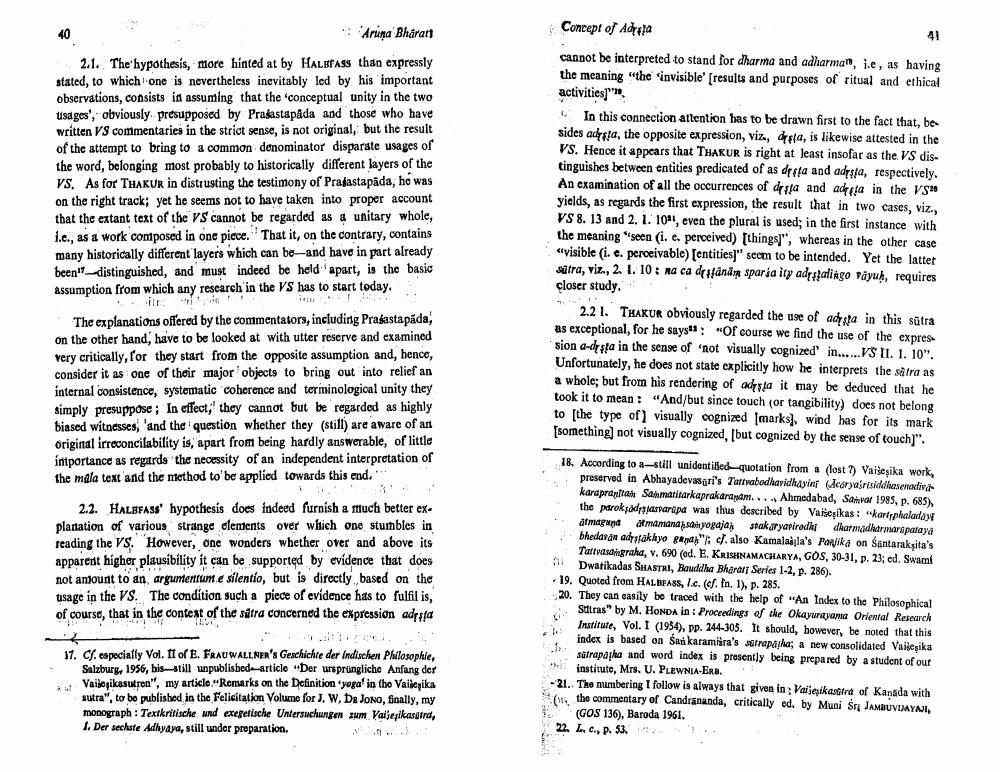Book Title: Note On Concept Adrsta As Used In Vaisesika Sutra Author(s): A Wezler Publisher: A Wezler View full book textPage 4
________________ Concept of Adela Arina Bharatt 2.1. The hypothesis, more hinted at by HALBfAss than expressly stated, to which one is nevertheless inevitably led by his important observations, consists in assuming that the conceptual unity in the two usages', obviously presupposed by Prasastapada and those who have written V9 commentaries in the strict sense, is not original, but the result of the attempt to bring to a common denominator disparate usages of the word, belonging most probably to historically different layers of the VS. As for THAKUR in distrusting the testimony of Prajastapäda, he was on the right track; yet he seems not to have taken into proper account that the extant text of the VS cannot be regarded as a unitary whole, i.c., as a work contposed in one piece. That it, on the contrary, contains many historically different layers which can be and have in part already been distinguished, and must indeed be held apart, is the basic assumption from which any research in the VS has to start today. cannot be interpreted to stand for dharma and adharman, le, as having the meaning "the invisible' (results and purposes of ritual and ethical activities] In this connection attention has to be drawn first to the fact that, be sides adysła, the opposite expression, viz., dreta, is likewise attested in the VS. Hence it appears that THAKUR is right at least insofar as the VS distinguishes between entities predicated of as dreta and adesta, respectively, An examination of all the occurrences of desta and adreta in the 1920 yields, as regards the first expression, the result that in two cases, viz., VS 8.13 and 2. 1. 10, even the plural is used; in the first instance with the meaning "seen (i. e. perceived) (things)", whereas in the other case styisible i.e. perceivable) (entities]" seem to be intended. Yet the latter sitra, viz., 2. 1. 10: na ca destånāra sparsa ity adspalingo Väyuh, requires closer study. 2.2 1. THAKUR Obviously regarded the use of adygta in this sūtra as exceptional, for he says": "Of course we find the use of the expres sion a-desta in the sense of not visually cognized' in......VS II. 1. 10". Unfortunately, he does not state explicitly how he interprets the safra as a whole; but from his rendering of adosta it may be deduced that he took it to mean: "And/but since touch (or tangibility) does not belong to the type of visually cognized marks), wind has for its mark [something, not visually cognized, but cognized by the sense of touch)". The explanations offered by the commentators, including Prabastapäda on the other hand, have to be looked at with utter reserve and examined very critically, for they start from the opposite assumption and, hence, consider it as one of their major objects to bring out into relief an internal consistence, systematic coherence and terminological unity they simply presuppose; In effect,' they cannot but be regarded as highly biased witnesses, and the question whether they still) are aware of an Original irreconcilability is, apart from being hardly answerable, of little importance as regards the necessity of an independent interpretation of the mala text and the method to be applied towards this end, 2.2. HALBFASS' hypothesis does indeed furnish a much better explanation of various strange elements over which one stumbles in teading the Vs. However, one wonders whether over and above its apparent higher plausibility it can be supported by evidence that does not antount to an argumentum e silentio, but is directly based on the usage in the VS. The condition such a piece of evidence has to fulfilis, of course, that in the context of the sátra concerned the expression adesta 18. According to a-still unidentified-quotation from a lost 7) Vaiseșika work, preserved in Abhayadevasgri's Tattvabodhavidhayini deryasrisidlasendid karaprania Sanmatitarkaprakaranam... Ahmedabad, Sava 1985, p. 685) the prokodnjavanipa was thus described by Vaišeşikas: kartphalalay armagana manandhyogaja) stakaryavirad dharmadharmarapalaya bhedavan adyslakkyo Ba " c. also Kamaladla's Paika on Santarakpita's Tattvasingraha, v. 690 (od. E. KRISHNAMACHARYA, GOS, 30-31, p. 23; ed. Swami Dwatikadas SHASTRI, Bauddha Bharari Series 1-2, p. 286). 19. Quoted from HALBFASS, 1.c. (cf. fo. 1), p. 285. 20. They can easily be traced with the help of "An Index to the Philosophical Sutras" by M. HONDA in: Proceedings of the Okayurayama Oriental Research Institute, Vol. I (1954), pp. 244-305. It should, however, be noted that this index is based on Sau karamiàra's satrapatha; a new consolidated Vaidepika satrapatha and word index is presently being prepared by a student of out i institute, Mrs. U. PLEWNIA-ER. -21. The numbering I follow is always that given in Valeikastra of Kanada with (w the commentary of Candrananda, critically ed. by Muni Śru JAMBUVIJAYNI, (GOS 136), Baroda 1961, 22. L. c., p. 53. .. 17. Cf.cspocially Vol. ff of E. FRAUWALLNER'S Geschichte der Indischen Philosophie, Salzburg, 1956, bis-still unpublished article Der ursprüngliche Anfang der Vaisikasutren", my article.Remarks on the Definition "yoga' in the Vaiseika sutra", to bo published in the Felicitation Volume for J. W. De Jono, finally, my monograph : Textkritische und exegetische Untersuchungen zum Valjepikardird, I. Der sechste Adhyaya, still under preparation.Page Navigation
1 2 3 4 5 6 7 8 9 10 11 12 13
